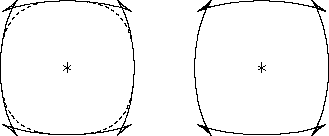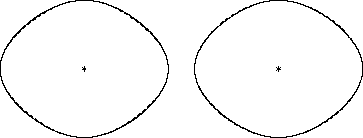 |
Figure 4 Compare
Our analysis in this paper was limited to simple kinematics. Before pronouncing the double-elliptic approximation a success, we need to also demonstrate how it works when used as the basis for an imaging technique; i.e, how accurately does it model the dynamics of the wave equation? Karrenbach (1991) examines this question in a companion paper.
 |
Two different double-elliptic approximations (dashed curves) fit to the qSV mode of Greenhorn Shale (solid curves). Left: the approximation is fit in the impulse-response domain, and so the dashed curve has a simple analytic form. Right: the approximation is fit in the dispersion-relation domain, and so is able to closely follow the triplication. This approximating curve can only be calculated parametrically, however, and so is less useful.
 |
Two different double-elliptic approximations (dashed curves) corresponding
to those in Figure ![[*]](http://sepwww.stanford.edu/latex2html/cross_ref_motif.gif) , but this time fit
to the qP mode of Greenhorn Shale (solid curves). (The size of the
``*'' in the middle shows the relative scales.)
The discrepancy is much less since there are no troublesome triplications.
, but this time fit
to the qP mode of Greenhorn Shale (solid curves). (The size of the
``*'' in the middle shows the relative scales.)
The discrepancy is much less since there are no troublesome triplications.